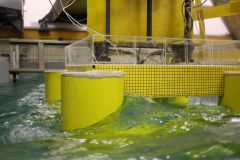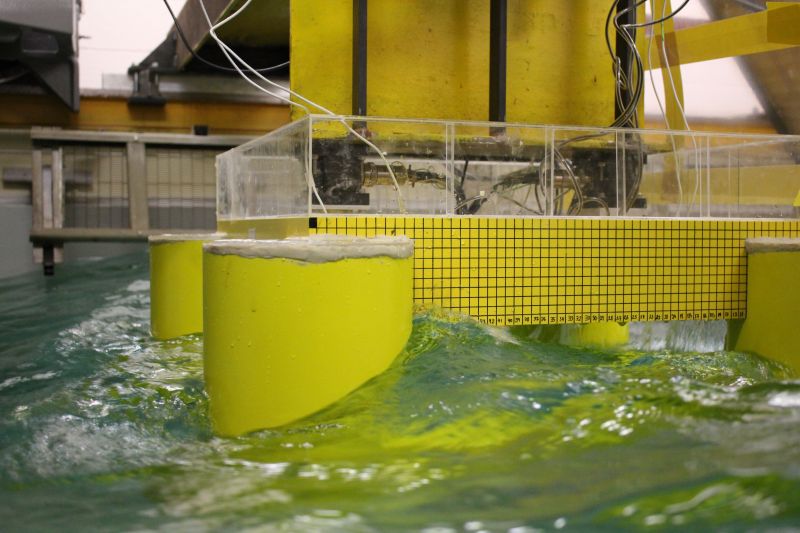
Open seas hold the promise of important resources as well as opportunities for exploration and food production. But severe weather events such as cyclones or hurricanes are more common in open waters, inducing wind velocities of up to 130 knots and creating waves up to 30 meters high.
In the Gulf of Mexico, more than 300 offshore platforms were lost or damaged in a series of hurricanes including Katrina, Ivan and Rita. In 2015, one worker tragically died and two were seriously injured when a large wave hit an offshore platform in the North Sea.
A lack of understanding of the behaviour of offshore platforms in large swells, and how they interact with waves, contributes to the devastation. Armed with an understanding of exactly how and where offshore platforms are impacted when extreme weather hits, maritime engineers would be able to design structures accordingly.
While an undersized structure may collapse, an oversized one may become too heavy to operate — or too costly. Key to the safe and efficient design of offshore structures, therefore, is being able to predict accurately how a wave’s forces will impact a structure during severe weather conditions at sea.
The project
At the Australian Maritime College, a research project on predicting the loads and motions on floating offshore structures in extreme wave conditions has just successfully concluded.
Dr Nagi Abdussamie conducted his postgraduate research using numerical and experimental techniques to investigate the phenomena. He explains why his research was necessary.
“Prior to this research, very little was known about the interaction of the wave, the structure, and resulting loads when a large waves hits a platform,”
Dr Abdussamie used computational fluid dynamics (CFD) to simulate the interaction of a tension leg platform — a type of offshore platform — in cyclonic wave conditions.
His findings were validated with a scale model of the offshore platform, which was tested in wave conditions in a 100-meter-long towing tank at the Australian Maritime College.
Dr Abdussamie explains what he discovered during his research, for which he was awarded a PhD.
“We found that there is a strongly non-linear wave diffraction under the platform, which can lead to increasing wave heights and significant impact loads on the platform. This is despite the fact that, theoretically, the wave should have passed the platform with no impact.”
Essentially: the modelling showed waves that were higher than theory predicted, and these waves hit the platform, including the deck. The deck is normally designed to sit above the ‘splash zone’ and is not expected to be reached by a wave.
Based on this finding, Dr Abdussamie concluded that offshore oil and gas structure designs must consider the deck — the topside of the structure, which sits above the sea level and has equipment installed upon it. Most platforms today are not designed for the possibility that the deck could be hit by a wave.
The damage caused by a wave hitting the deck could be avoided by increasing the air gap — the space between the sea level and the topside deck — although this could raise the platform’s centre of gravity, which could in turn affect its stability.
An alternative solution would be to reinforce areas of the topside structure to ensure they can withstand such rare waves; a solution that would require a precise understanding of the load magnitudes that the structure would be subjected to.
The research was advised by Dr Yuriy Drobyshevski from INTECSEA, a designer of large offshore platforms. He explains the practical importance of research in this field.
“Although events where waves hit offshore platform decks can have disastrous consequences, the causes and physics of such events remain poorly understood and not well predictable.
“Recent accidents have shown that many aspects of such events are overlooked by today’s engineering practice, and there is no guarantee that even more serious accidents won’t happen again. This type of research is critical to rectifying this.”
Dr Roberto Ojeda, Senior Lecturer at the Australian Maritime College, supervised the research. He explains how it broke new ground.
“During this research, cutting-edge simulation techniques of wave-in-deck events were validated against high-fidelity towing tank model-scale experiments.
“The experimental validation of the numerical techniques gives us enough confidence to apply them to various scenarios covering a wide range of environmental conditions.
“These results provide new knowledge and invaluable insights to scientist and engineers wanting to design safer offshore installations.”
Research expertise
This project is not the only one of its kind underway at the Australian Maritime College.
Over 100 staff members are responsible for educating students, conducting research projects or providing consultancy for a variety of maritime projects.
“We’ve conducted many studies using computational fluid dynamics in conjunction with model-scale testing to investigate forces, motions and interaction effects of ship or maritime structures in waves,” said Dr Max Haase, a consultant with AMC’s commercial arm, AMC Search.
Typical applications include floating offshore storage and production (FSPO) facilities, floating liquid gas (FLNG) units, tug-ship and ship-ship interaction in a confined port environment.
Dr Haase is responsible for the commercial implementation of numerical simulation techniques. He explains its value.
“We validate our numerical models in our experimental facilities, but only numerically can we run a large number of design variations and different test conditions in a time and cost effective way. This makes numerical modelling very attractive for the Australian and international maritime industry.”
AMC’s hydrodynamic facilities comprise a towing tank, a model-test basin, a circulating water tank and a cavitation tunnel. The suit of facilities is unique in Australia and amongst the most advanced in the world. More information on AMC’s hydrodynamic facilities.
More information on AMC Search research consultancy.
Published on: 31 Jan 2017
